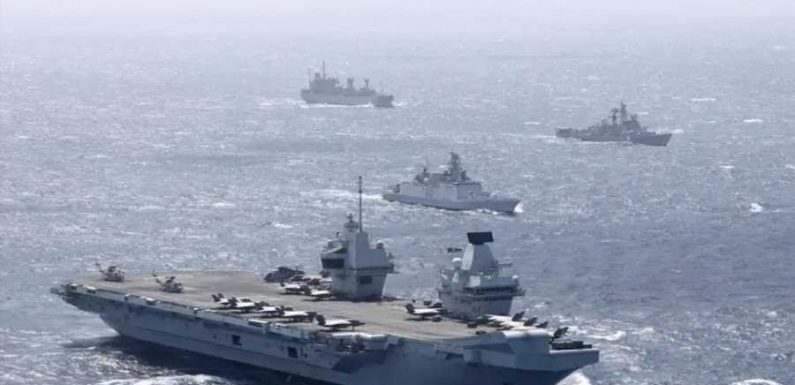
THE UK’s biggest warship has entered the South China Sea, despite Beijing’s warning of punishment for sailing into the disputed waters.
HMS Queen Elizabeth is currently on exercises in the sea and is set to risk further Chinese wrath for challenging their claim to control vast swathes of the area.
The £3 billion Royal Navy aircraft carrier is currently taking part in wargames in the southern reaches of the South China Sea, involving eight ships, including three from Singapore.
China claims almost all of the 1.3 million square-mile South China Sea as its territory.
In response, the United States and its allies including the UK sail warships through the sea in freedom of navigation operations to challenge its claim, angering Beijing.
China’s hackles have already been raised, with one military commentator issuing a warning in state mouthpiece Global Times to Britain to stay away.
"If the UK wants to provoke the Chinese People's Liberation Army in the South China Sea, it will inevitably lead to strong countermeasures from China,” said Song Zhongping.
“An old saying in China goes that if you want to punish someone, you need to consider saving face for his big brother.
"However, what China will do is just the opposite: China will make it clear to the US that London will be punished by acting like Washington's running dog in provoking Beijing."
He was joined by Chinese defence spokesman Tan Kefei who said “the real source of miltarisation” in the region was countries “sending their warships thousands of kilometres from home to flex muscles”.
'STRONG COUNTERMEASURES'
“The Chinese military will take necessary measures to safeguard its sovereignty, security and development interest as well as peace and stability in the South China Sea,” he said.
But the US Secretary of Defence Lloyd Austin has hit back at China’s territorial claim.
“Beijing’s claim to the vast majority of the South China Sea has no basis in international law,” he said.
“That assertion treads on the sovereignty of states in the region. We continue to support the region’s coastal states in upholding their rights under international law.”
The 65,000 tonne HMS Queen Elizabeth symbolically passed through the Singapore Strait on Monday to enter the South China Sea, where it will be in range of China’s hypersonic “carrier killer” missiles.
The ship on its first deployment at the heart of the UK’s Carrier Strike Group, which is on a 28 week tour of 40 countries.
It next undertake a series of multinational exercises in the Philippine Sea and will return to Singapore later in the year.
HMS Albion was the last UK warship to enter the South China Sea, back in 2018, and was challenged by a Chinese frigate and two helicopters.
What is the dispute in the South China Sea about?
The dispute centres around legal claims to ocean areas and two island chains, the Paracels and the Spratlys, which are thought to be abundant in natural resources.
Every year some £3.8 trillion of trade passes through the dispute area and the United States has been joined by Australia, the UK and France in sailing warships through it to assert freedom of navigation
China has engaged in a massive military build-up in the area, creating a network of artificial islands, which it uses to assert its territorial claim.
It claims that these are part of its national coastline but the United States and the Philippines say that doesn't apply to artificial islands.
China's claim to a 12 mile territorial limit around the islands is not internationally recognised.
Warships from the United States and China have been engaged in tense stand-offs which have threatened to escalate into conflict in the disputed seas.
In January 2020, China reacted with fury after the US sent a missile destroyer through the disputed waters in a direct challenge to Beijing.
China responded by scrambling warships and aircraft to intercept the ship, which sailed within a dozen miles of the increasingly-militarised Paracel Island chain.
Source: Read Full Article

